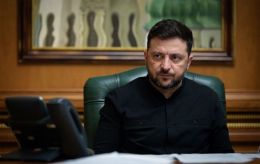'Fate was preparing him for war': Story of Ukrainian defender who came out of Ilovaisk but killed in Bakhmut
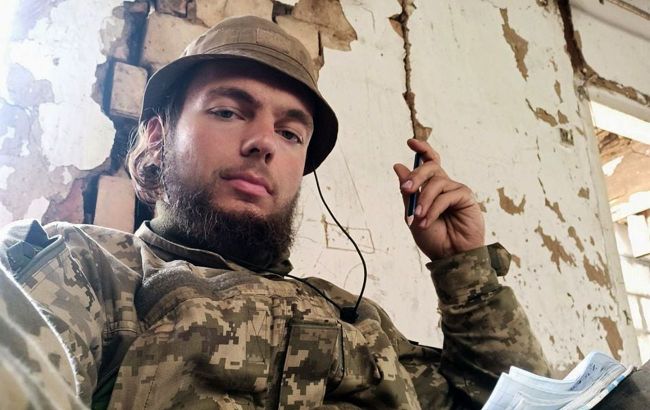 Oleksandr Hoshylyk (photo provided by Viktor Hoshylyk)
Oleksandr Hoshylyk (photo provided by Viktor Hoshylyk)
On August 29, all soldiers who have fallen for Ukraine are remembered annually. It was on this day 10 years ago that Russian invaders shot Ukrainian defenders at the exit from the Ilovaisk cauldron. In the battles for the city, 368 Ukrainian soldiers were killed, and 18 are missing.
One of the youngest fighters to leave Ilovaisk was Oleksandr Hoshylyk, who went by the call sign “109”. He was 18 years old at the time.
Originally from Dolyna, Ivano-Frankivsk region, Sashko volunteered to fight in the Anti-Terrorist Operation zone in 2014 as a member of the Donbas battalion. A year later, he became a holder of the Order for Courage, III class. In 2016, he resigned from the service, and after Russia's full-scale invasion, he again defended Ukraine. On October 7, 2022, Oleksandr was killed in action near Bakhmut.
RBC-Ukraine asked Oleksandr's father, Viktor Hoshylyk, about his son's childhood and adolescence, his exit from the Ilovaisk cauldron, and his death near Bakhmut.
Below is Victor Hoshylyk's direct speech
He had been daydreaming of war since childhood
Sashko is my youngest son. From early childhood he was sick a lot, but only at the age of 16 did he find out that he was missing one kidney. That's why he volunteered for the war because he knew that otherwise he would not be accepted.
Sashko's first poems as a child were about the war. I don't know why, but he often dreamed that he was at war. Later, he told his sister that it was fate that was preparing him for it. In 2016, Oleksandr Hoshylyk published a collection of poems called The Bridge Through Eternity under the pseudonym Kliatyi Molfar (Damned Molfar - Ed.).
Sashko was a first-rate chess player, participated in numerous competitions, even international ones, and showed good results. He spent all the prize money from his tournament winnings on books. He loved to read and had his library.
 Little Sashko in his father's arms (photo provided by Viktor Hoshylyk)
Little Sashko in his father's arms (photo provided by Viktor Hoshylyk)
At the age of 13, Sashko lost his mother, and his two older sisters became his support. About a month after my wife's death, teacher Myroslav Harazd suggested that I take my son to extra physics lessons. Sashko was one of those boys who did not like physics, but after the first lesson, he did not need to be persuaded. Within a month, he became a prize-winner at the district Olympiad, a month later - at the regional Olympiad, and a few months later - at the All-Ukrainian Olympiad.
After the All-Ukrainian Olympiad, he was noticed at a lyceum at Shevchenko University in Kyiv, and he went to study there. Later, he entered the university, and it was there that he was caught up in the events on the Maidan.
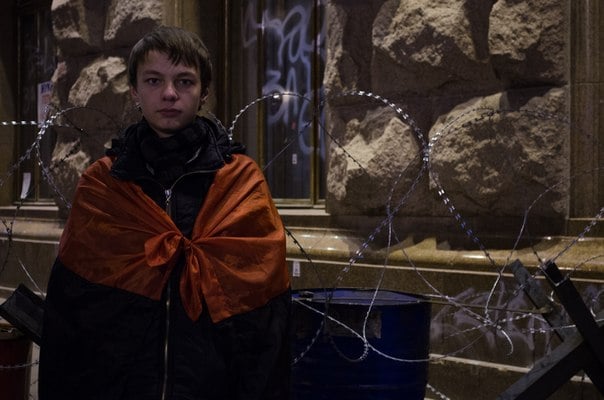
Sashko at Maidan (photo provided by Viktor Hoshylyk)
From Maidan to war
Sashko was on the Maidan from the first to the last day. He created a group called Maidan of Action, where he encouraged other students to join the protests.
I also came to the Maidan because I could not bear to see children being beaten. On February 20, 2014, we were different - my son was with the students. When the shootings began and the bodies were being brought to the barricades, I was afraid that I would recognize Sasha in each new victim.
During the Revolution of Dignity, my son was detained by the police, he was not held for long but was accused of calling for disobedience. This is Article 109 of the Criminal Code. That's how he got his call sign, 109. After the Maidan, Sashko said: “The revolution has not yet won. We fought here not just to transfer power from one political force to another. We have other pro-European ideas.”
After the Maidan, his son asked to volunteer for one battalion or another. They didn't want to take him because he looked too young. When I found out about his intentions, it was too late. He had already enlisted in the Donbas battalion. I tried to dissuade him and his sisters: “Well, where are you going, son, what war at 18?” Sasha replied: “Dad, you raised me this way, and now you want me to betray it all?”
 Sashko at Maidan (photo provided byViktor Hoshylyk)
Sashko at Maidan (photo provided byViktor Hoshylyk)

Sashko at Maidan (photo provided by Viktor Hoshylyk)
Exit from Ilovaisk cauldron
Sashko took part in his first battle on May 15, 2014, in the village of Karlivka, Donetsk region, as part of the Donbas battalion. Three volunteers were killed that day. Later, Sashko became a mortar fire adjuster. When they entered Ilovaisk, they had only two mortars.
At the time, we thought Sashko was in Kurakhove. He called us from the roof of a broken school because it was the only place where there was a normal connection. My son reassured me, saying that he was fine, even though I could hear shots in the background.
From Sashko's story, I know that he was traveling in the back of a car with four other guys in the convoy. When they stopped, the commander called him to him, and at that moment a shell hit the back of the car. Three soldiers were killed immediately, and one was wounded.
When the convoy was shot, the guys scattered. They decided to go out on their own. At first, they were walking in groups of four, but at night they came across another group of five fighters. The guys thought they were separatists. Sashko was accompanied by a fighter from Lviv with the call sign “Antykvar,” who took the pin out of a grenade and started attacking the strangers. Both groups were ready to shoot each other. But at the last moment, my son recognized Dudaiev, a fighter with whom he had previously served, among the strangers and shouted that they were his own. They went on together.
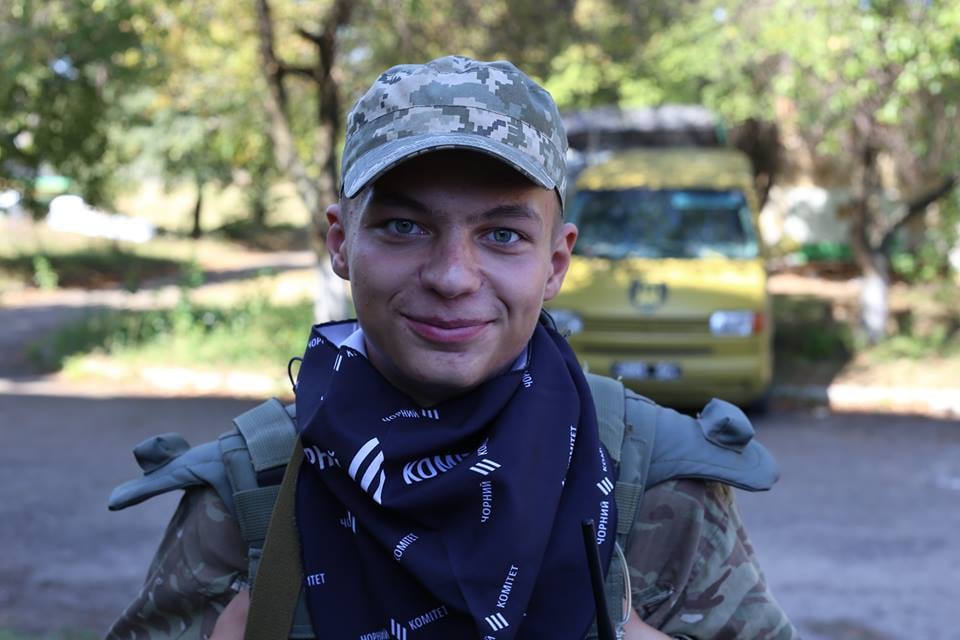 Oleksandr Hoshylyk during his service in the Donbas volunteer battalion (photo provided by Viktor Hoshylyk)
Oleksandr Hoshylyk during his service in the Donbas volunteer battalion (photo provided by Viktor Hoshylyk)
Sashko used GPS to lead the group out of the cauldron. At night, they approached a railroad crossing and ran into an ambush. Sashko heard one of the enemies say: “Let's let them get closer and then we'll shoot.” His son warned his men, and he took off his assault rifle, reloaded it, and while falling, opened fire on the separatists. Sashko realized that by doing so, he would draw the shots to himself and take the danger away from the guys. They neutralized the enemies, but Dudaiev from their group disappeared without a trace. It is still unknown where he is and what happened to him.
The guys had been walking for 5 days, they were very hungry, so they ate what they found in the fields. The son recalled that he had never thought that raw corn could be so tasty. One day they ate watermelons and were lying in the greenery (that's what the military calls the fields - Ed.), and a Russian column passed by. The guys were already so exhausted and could not move after eating watermelons that they decided to just wait for the column and the Russians passed them.
Sashko and his comrades walked 85 kilometers until they reached our line and were immediately sent to Dnipro.
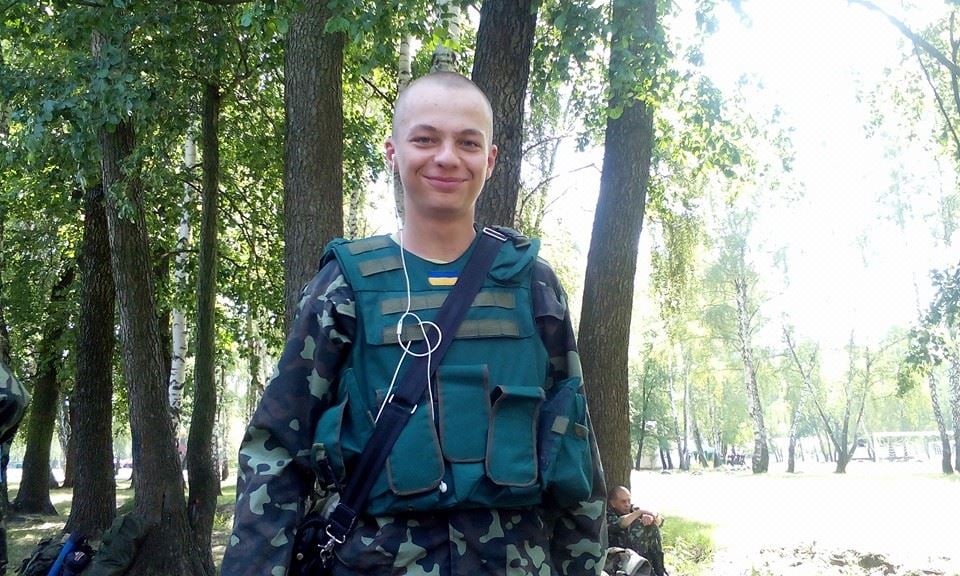 Sashko went to the front at the age of 18 (photo provided by Viktor Hoshylyk)
Sashko went to the front at the age of 18 (photo provided by Viktor Hoshylyk)
When the convoy was shot in Ilovaisk, we did not know whether Sashko was alive or dead. Then we went to the Hoshiv Monastery in Dolyna to pray. This is a very holy place. And when the priest was reading the Our Father, Sasha sent me a text message that he was alive.
In Ilovaysk, Sashko regained his faith in God, which he lost after his mother's death. As a child, he was looking for an explanation for why this happened in our family. “I fought with God in my heart until I found him in hell,” Sashko wrote in one of his poems.
The son recalled that when he and his fellow Donetsk resident Liubomyr arrived in Kyiv after Ilovaisk, they decided to go to a charity concert. Liubomyr's legs were injured, and Sashko's were swollen after coming out of the cauldron. It was only then, during Tartak's song Knight's Cross, that the boys realized they had survived. They started dancing and shouting: “We are alive, we made it out”. The people around them looked at them as if they were fools - they could not even imagine that the boys had been through such a thing.
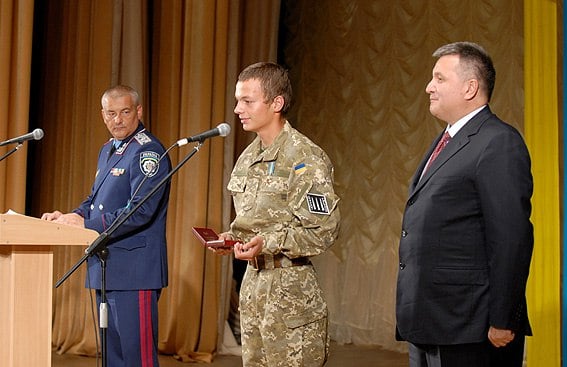
In 2015, Sashko became a holder of the Order of Courage (photo provided by Viktor Hoshylyk)
Finding himself in civilian life
After Ilovaisk, Sashko served for two more years. It was very hard for him, like for the other guys who came out of the cauldron. He woke up in the middle of the night many times, saying that he could hear the guys screaming, but could not remember their faces. His family, friends, books, and professional psychologists helped him find balance in his life.
It was hard for Sashko, he dropped out of school, even though my daughters and I persuaded him not to. My son was very much appreciated at the university, and he even developed a program to determine the coordinates of targets with one of his professors.
A month later, he decided that he wanted to become a programmer. He found a company in Zakarpattia that was recruiting 15 people for training. Then he was among the two people the company hired.
He was like a sponge - he quickly absorbed everything and easily learned new things. He proved himself well in that company, then moved to a Kyiv-based firm. Later he found another one. In a few years, he became a leading programmer, reaching the highest senior level.
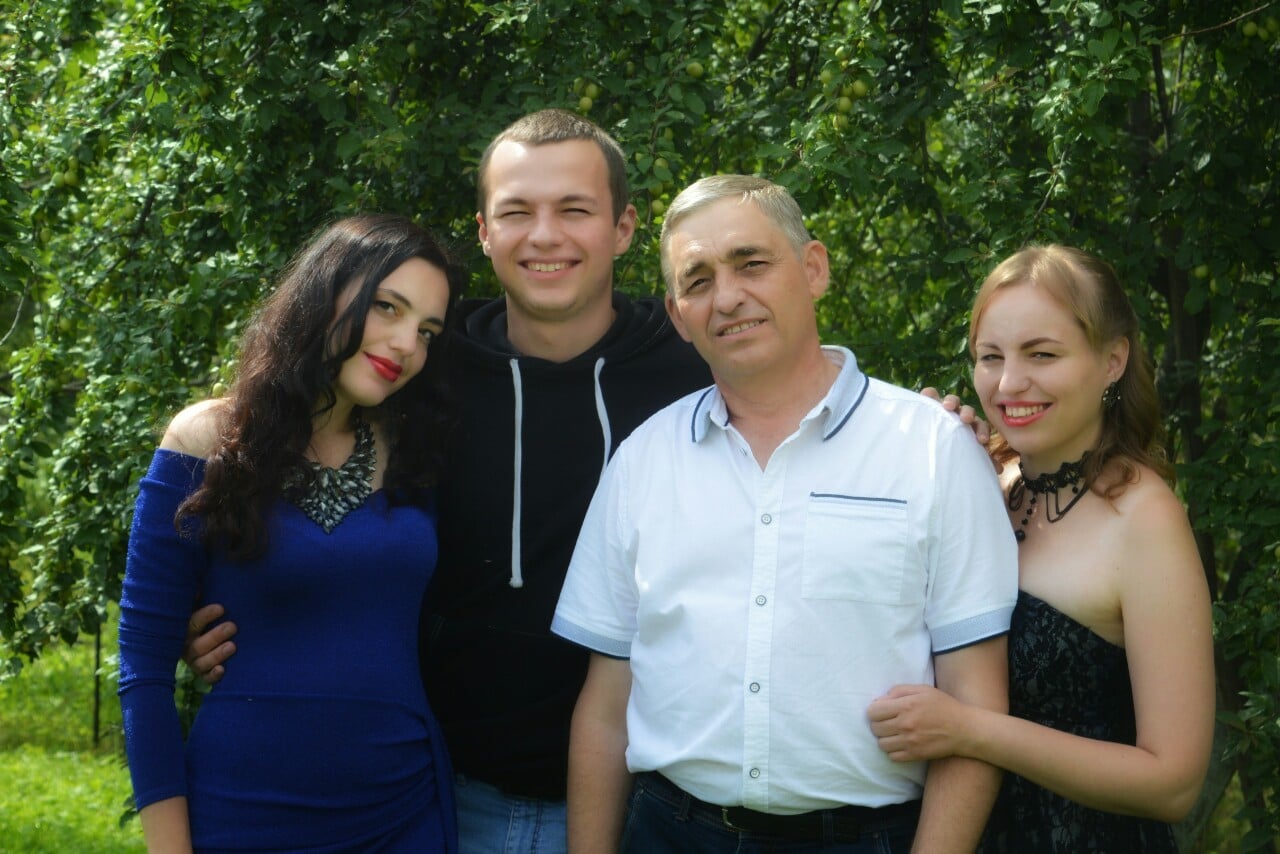 Sashko with his father and sisters (photo provided by Viktor Hoshylyk)
Sashko with his father and sisters (photo provided by Viktor Hoshylyk)
The last battle near Bakhmut
On February 21, 2022, Sashko was already cutting off the phones of the military registration and enlistment office in Kyiv to enlist in the Armed Forces of Ukraine. He had to go to them for another week to get enlisted in the territorial defense. My daughters and I convinced him that he was a programmer and could join the cyber army. Sashko replied that he was a mortar operator and knew how to fight, and that other guys needed to be taught.
My son realized that he could do nothing in the territorial defense, so he joined the 30th Separate Mechanized Brigade named after Prince Kostiantyn Ostrozkyi. At first, he was an assistant, then he became a platoon commander. It was in this position that he was killed while saving his comrades 5 kilometers from Bakhmut in the village of Odradivka.
I know exactly how it happened. On October 7, 2022, at about 1:30 p.m., 3 Russian Wagner soldiers dressed in Ukrainian uniforms came to the mortar positions. The Russians were ready to shoot Ukrainian guys, but Sashko intercepted them before they did. He somehow realized that they were Russians. He went out to them himself and offered to surrender. They refused. He managed to put two of them down, but the third one fired an automatic burst at Sashko.
In 10 minutes, our guys crawled to my son, but he was already dead. Russians attacked, so our guys could not take Sashko away. I am still not given any hope of getting the body back. Officially, my son is considered missing.
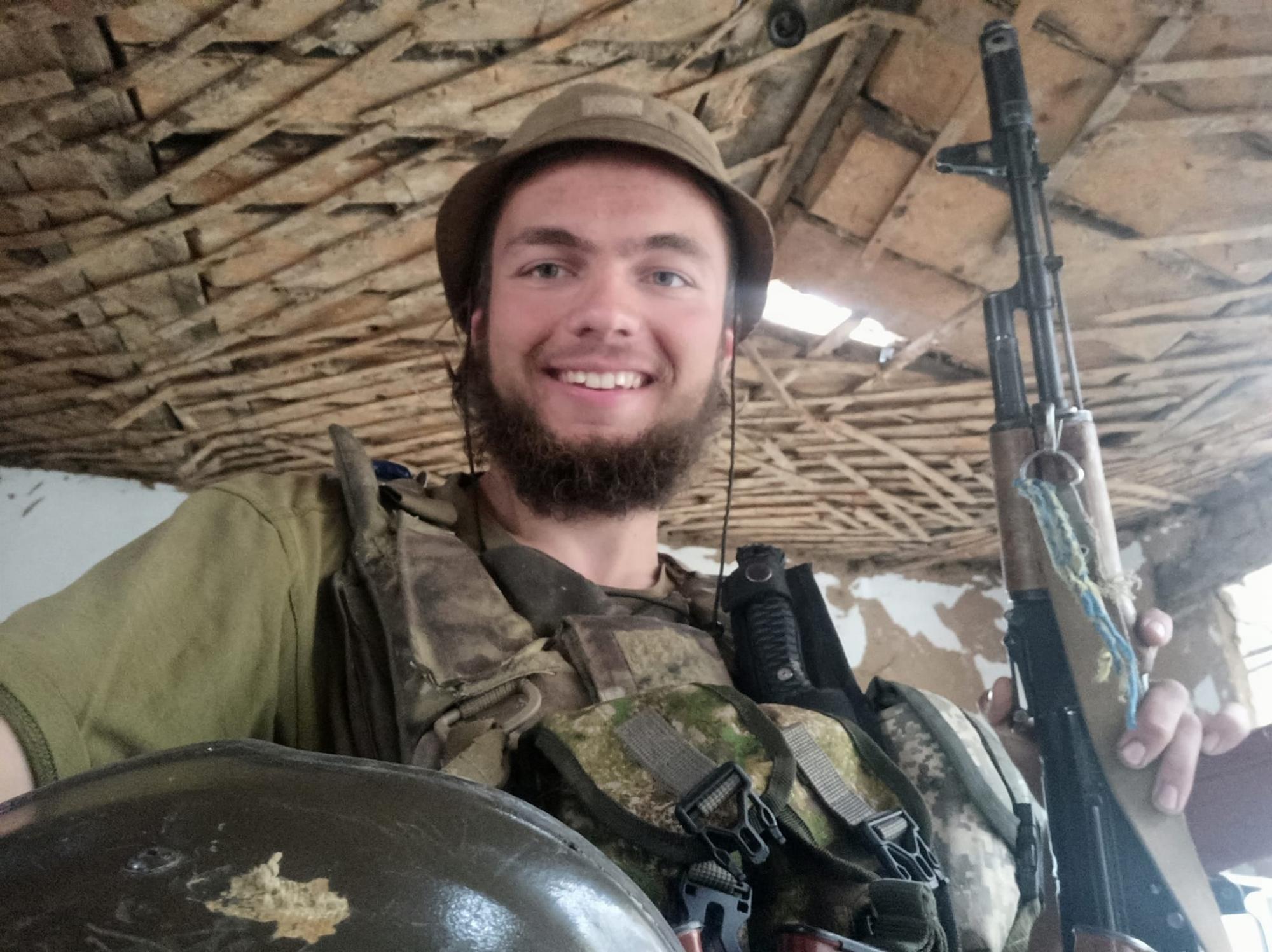 One of the last photos of Sashko (photo provided by Viktor Hoshylyk)
One of the last photos of Sashko (photo provided by Viktor Hoshylyk)
Keeping Sashko's memory alive
My daughters, friends, and other Ukrainians who care about Sashko keep Sashko's memory alive. We organized an all-Ukrainian chess tournament in Dolyna. Now we are preparing his second collection of poems for publication. Several of Sashko's poems were set to music. The song “Mom” by Vasyl Andrusiv, a musician from Dolyna, based on his son's poem, has become very popular. The video clip for this song and several other poems by Sashko won first prize in the international competition Ukraine Unites the World.
The Ukrainian Physics and Mathematics Lyceum of the Taras Shevchenko National University of Kyiv, where Sashko studied, immortalized the memory of its graduate with a memorial plaque. They also established the annual literary contest Life is Beautiful named after Oleksandr Hoshylyk (Sashko had a tattoo on his wrist that read La vita è bella, which means Life is Beautiful in Italian - Ed.).
The publicist Oksana Rovenchak wrote a research paper about Sashko's poetry, “War is blackened by crosses... A candle burns in the glow of a word.” Later, she submitted his work to the international competition of the Franz Kafka Literary and Art Prize (Germany - Austria - Czech Republic), where Sashko was posthumously awarded the prize.
The IT firm Verbit, where Sashko worked before Russia's full-scale invasion of Ukraine, annually holds a memorial evening in his memory.
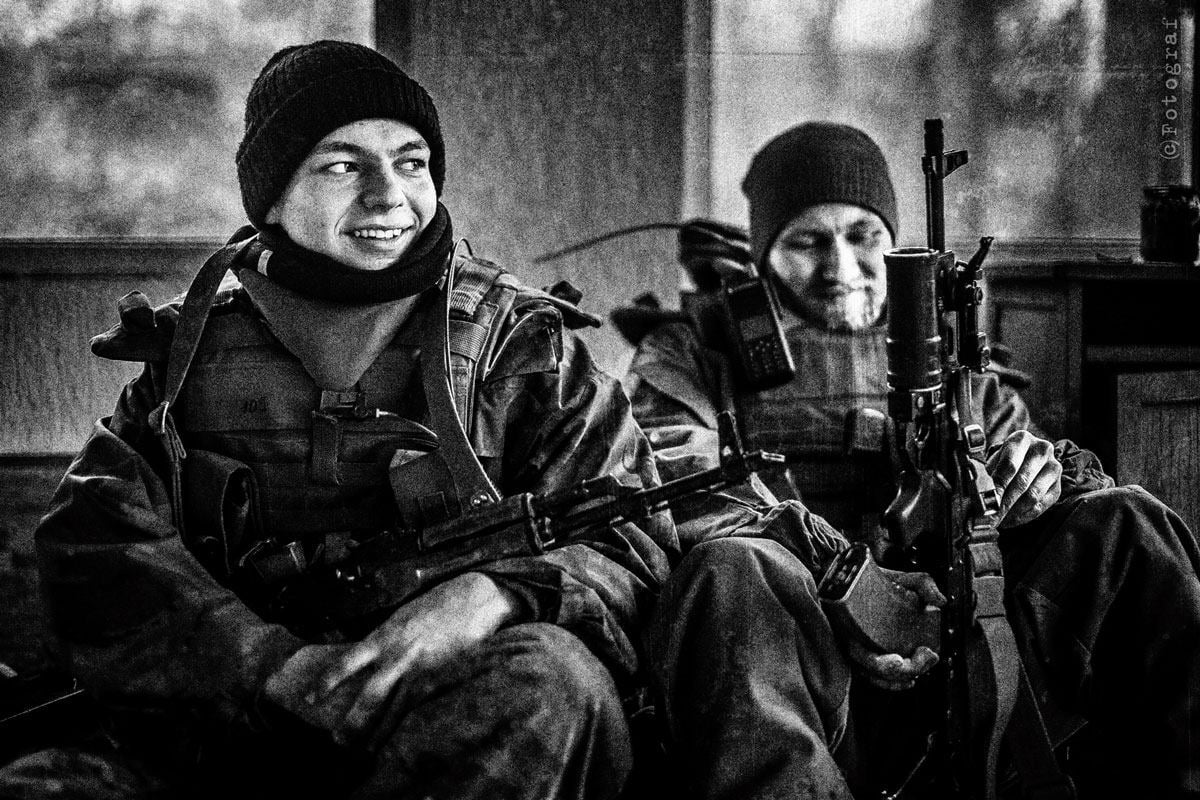 Sashko and his comrade-in-arms Liubomyr at their positions (photo provided by Viktor Hoshylyk)
Sashko and his comrade-in-arms Liubomyr at their positions (photo provided by Viktor Hoshylyk)
“My daughters, three grandchildren, my second wife, and even Sashko himself help me to stay strong. He was extremely strong, and I am learning from him how to be like him. Even the last time we saw each other during a rotation in Kyiv three months before his death, he reassured me and joked with me.
His last four poems were like testaments. A week before he died, his friend died. He dedicated a poem to him, in which he wrote that they would meet in heaven and contemplate our Ukraine. The following poems were to friends, Ukrainians, and descendants.
Having found a way, I finally came out,
In my body, I kept my life
But many died without hope
And many more with hope who died.
(a quote from the poem “Roulette” by Oleksandr Hoshylyk, written after Ilovaisk)
